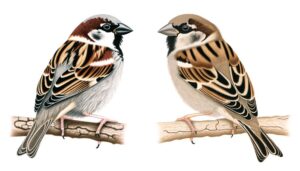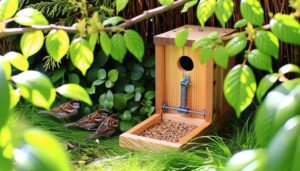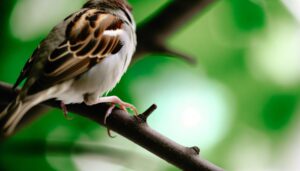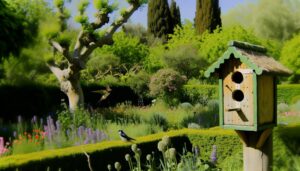How Long Do House Sparrows Stay in the Nest?
House sparrows typically stay in the nest for around 14 to 16 days after hatching. Throughout this time, parents offer thorough care like feeding and keeping warm.
The period of keeping the eggs warm before hatching varies from 10 to 14 days, affected by factors like temperature and humidity. Successive egg laying guarantees synchronized hatching, aiding in coordinated parental care.
After hatching, nestlings experience quick growth, acquiring crucial motor abilities and developing feathers in readiness for flying. If you desire a more profound insight into their growth stages and parental actions, you may discover additional details fascinating.
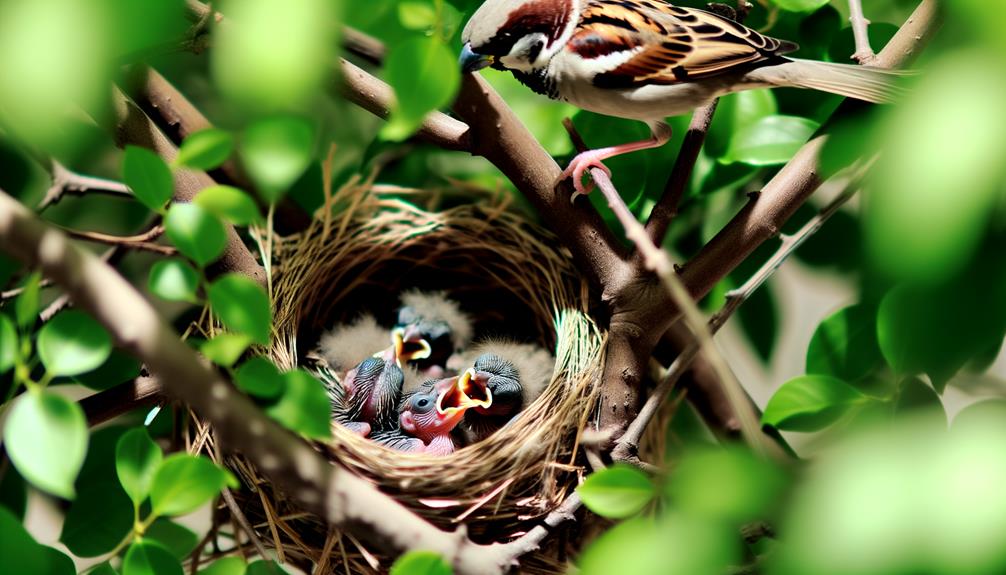
Key Takeaways
- House sparrow chicks typically fledge and leave the nest 14 to 17 days after hatching.
- Parental care continues in the nest, including feeding and protection, until fledging.
- The chicks gradually develop feathers and strength needed to leave the nest.
- Both parents assist in feeding and ensuring the chicks' growth and safety.
- Sufficient nutrition and favorable conditions can influence the fledging period duration.
Egg Laying Period
During the egg-laying period, female house sparrows (Passer domesticus) typically deposit one egg per day until their clutch, averaging four to five eggs, is complete. This sequential laying process guarantees that the eggs develop synchronously and increases the likelihood of simultaneous hatching.
The eggs are elliptical and measure approximately 22.5 mm in length and 16 mm in width. They exhibit a white to pale gray base color, often speckled with brown or gray markings. The laying period is critical for ensuring ideal embryo development, with ambient temperature and nutritional intake playing pivotal roles.
Studies indicate that a well-defined laying period, coupled with stable environmental conditions, enhances reproductive success and chick viability in house sparrows, thus contributing to population stability.
Incubation Duration
The incubation duration for House Sparrows (Passer domesticus) typically spans 10 to 14 days, influenced by environmental conditions and parental care. Factors such as ambient temperature, humidity, and nest location can greatly impact the length of this period.
Both male and female sparrows contribute to incubation, although the female primarily assumes this role, ensuring ideal conditions for embryonic development.
Typical Incubation Period
House sparrows display an incubation period lasting around 10 to 14 days. Throughout this period, the female typically takes on the main responsibility for incubating the eggs, although males may occasionally assist.
The incubation period is crucial for the embryonic development of the chicks, ensuring they reach the necessary physiological milestones before hatching. Eggs are usually turned multiple times per day to guarantee even temperature distribution and prevent the embryo from adhering to the shell.
This phase is characterized by a stable microenvironment within the nest, optimized for temperature and humidity to promote ideal growth conditions. The exact duration can vary slightly, influenced by factors such as ambient temperature and individual bird behavior, but generally follows this typical timeframe.
Factors Influencing Duration
Ambient temperature, parental behavior, and egg handling practices are pivotal factors that can influence the duration of the incubation period in house sparrows. Research indicates that ideal ambient temperatures, typically ranging between 35-37°C, can expedite embryonic development, thereby potentially reducing the incubation period.
Conversely, fluctuating or extreme temperatures can prolong it. Parental behavior, including the frequency and duration of incubating sessions, affects heat transfer to the eggs, thereby impacting development rates. Additionally, egg handling practices such as turning the eggs uniformly enhance embryonic growth by preventing developmental abnormalities.
Data suggest that these combined factors can lead to variations in the typical 10-14 day incubation period observed in house sparrows, underscoring the complex interplay of environmental and behavioral influences.
Parental Incubation Roles
Parental incubation roles in house sparrows are characterized by a division of labor between males and females, directly influencing the duration and effectiveness of the incubation period. Females mainly undertake the incubation, spending approximately 60-80% of daylight hours on the nest.
Males contribute by foraging and defending the territory, ensuring best conditions for embryo development. The typical incubation period lasts 10-14 days, contingent upon ambient temperature and food availability. Research indicates that consistent parental care, particularly by the female, enhances hatching success rates.
The male's role, although less direct, is vital in maintaining environmental stability around the nest. This division of labor maximizes reproductive success, with both parents contributing to an effective incubation strategy, ensuring the well-being of the offspring.
Hatching Process
The hatching process of house sparrows commences after an incubation period averaging 11 to 14 days. During this time, embryonic development progresses through specific stages, resulting in fully formed chicks ready to emerge from their eggs.
Parental care dynamics play an important role in this phase, with both parents alternating incubation duties and ensuring ideal conditions for chick development.
Egg Incubation Period
Incubation of house sparrow eggs typically spans 11 to 14 days, during which time the embryos undergo significant stages of development. During this period, both parents may participate in maintaining ideal conditions for successful hatching.
The incubation process involves several key factors:
- Temperature Regulation: Maintaining a consistent temperature of approximately 37.5°C.
- Moisture Control: Ensuring adequate humidity to prevent desiccation of the eggs.
- Turning Frequency: Regularly rotating the eggs to avoid adhesion of the embryo to the shell.
- Parental Behavior: Both male and female sparrows share incubation duties.
- Developmental Milestones: Embryos progress through stages of organogenesis, skeletal formation, and feather germination.
Understanding these factors is essential for appreciating the intricacies of avian reproductive biology and the hatching success of house sparrows.
Chick Development Stages
Typically, the hatching process of house sparrow chicks begins after approximately 11 to 14 days of incubation, marked by the chick's initial efforts to break through the eggshell using an egg tooth. This specialized, temporary structure located on the upper beak aids in penetrating the eggshell, a process known as pipping.
Pipping can last several hours, during which the chick intermittently rests and resumes its efforts. Upon successful breaching of the eggshell, the chick emerges, often covered in a thin layer of down feathers and with closed eyes.
This critical phase signifies the onset of neonatal development, characterized by rapid physiological changes essential for survival. The hatching process demonstrates the intricate balance of biological timing and mechanical effort necessary for avian emergence.
Parental Care Dynamics
Following the hatching process, parental care dynamics become vital as adult house sparrows undertake the essential tasks of feeding, brooding, and protecting their newly emerged chicks. During this period, both parents exhibit a high degree of coordination and division of labor to guarantee optimal chick survival.
Key activities of parental care include:
- Feeding Frequency: Parents make approximately 20-30 feeding trips per day.
- Nutritional Provision: Diet primarily consists of insects, particularly during the early stages.
- Thermoregulation: Adults brood chicks to maintain necessary body temperatures.
- Nest Sanitation: Regular removal of fecal sacs to ensure a clean environment.
- Predator Defense: Vigilant guarding and aggressive behaviors to deter potential threats.
This multi-faceted approach underscores the complexity and significance of parental investment in avian reproductive success.
Nestling Development
Nestling development in house sparrows is characterized by rapid physiological and morphological changes that occur within the first two weeks post-hatching. During this pivotal period, nestlings experience significant growth in body mass, feather development, and behavioral adaptations necessary for survival. By day 5, pin feathers begin to emerge, and by day 10, feathering is nearly complete. Additionally, nestlings exhibit substantial increases in weight and size, essential for thermoregulation and eventual fledging.
| Day Post-Hatching | Key Developmental Milestones |
|---|---|
| 1-3 | Initial growth, eyes closed |
| 5 | Emergence of pin feathers |
| 10 | Near-complete feather development |
Understanding these developmental stages is crucial for comprehending the dynamics of house sparrow nestling survival and growth.
Feeding Behavior
Feeding behavior in house sparrow nestlings is characterized by frequent and intense parental provisioning, crucial for supporting their rapid growth and development. Adult sparrows exhibit highly efficient foraging strategies to meet the dietary needs of their young.
Observations indicate that:
- Feeding frequency: Parents feed nestlings roughly every 5 to 15 minutes.
- Diet composition: Diet mainly consists of insects and other invertebrates, offering high protein content.
- Feeding technique: Parents deliver food directly into the gaping mouths of nestlings.
- Parental roles: Both male and female sparrows participate in feeding, although females often contribute more.
- Energy demands: Nestlings' high metabolic rates necessitate continuous and substantial food intake.
This intensive feeding regimen guarantees that nestlings receive adequate nutrition to sustain their developmental processes.
Growth Milestones
House sparrow nestlings undergo distinct growth milestones marked by rapid physical and behavioral changes within the first few weeks of life. Initially, they exhibit minimal mobility and are dependent on parental care for nourishment. By the end of the first week, nestlings begin to open their eyes and develop primary feathers. During the second week, motor skills improve, allowing for limited movement within the nest. Concurrently, feather growth progresses, providing better thermoregulation. By the third week, nestlings display increased vocalization and self-feeding attempts, indicative of their cognitive and physical development.
| Week | Developmental Milestone | Behavioral Change |
|---|---|---|
| 1 | Eye opening, feather growth | Minimal mobility |
| 2 | Motor skill improvement | Limited nest movement |
| 3 | Increased vocalization | Self-feeding attempts |
| 4 | (Next Subtopic: Fledging) | (Next Subtopic: Fledging) |
Fledging Timeframe
The fledging process for house sparrows typically commences around the fourth week post-hatching, marking a critical shift from nest dependency to independent survival. This period involves significant developmental milestones that guarantee the fledglings are adequately prepared for life outside the nest.
Key indicators of readiness for fledging include:
- Feather Development: Adequate growth of flight feathers for initial flights.
- Weight Gain: Achieving a body mass sufficient for energy reserves.
- Wing Flapping: Practicing wing movement to strengthen muscles.
- Vocalization: Developing communication skills necessary for interaction with conspecifics.
- Exploratory Behavior: Initial attempts to leave the nest and explore surroundings.
These indicators collectively signal the fledglings' preparedness for the challenges of independent survival.
Parental Care
In house sparrows, parental care extends beyond mere feeding, encompassing a range of behaviors necessary for the survival and development of the fledglings. Both parents actively participate in brooding, maintaining the best nest temperature for thermoregulation.
Frequent feeding intervals, approximately every 20 minutes, guarantee adequate nutritional intake. Parents remove fecal sacs from the nest to maintain hygiene, reducing disease risk.
Vigilance against predators and aggressive intruders is a vital aspect of their care. Studies indicate that parental investment significantly impacts fledgling fitness, with increased parental activity correlating with higher fledgling survival rates.
This multifaceted parental effort underscores the complexity and importance of care strategies in the early life stages of house sparrows.
Post-Fledging Stage
Following the intensive parental care during the nestling phase, fledgling house sparrows face new challenges as they leave the nest and begin the post-fledging stage. This critical period involves significant developmental milestones essential for survival and independence.
The post-fledging period typically lasts 7 to 14 days, during which fledglings are still reliant on parental feeding and protection. Key aspects of this stage include:
- Flight Proficiency: Fledglings must develop strong flight muscles and coordination.
- Foraging Skills: Learning to identify and gather food independently.
- Predator Avoidance: Acquiring strategies to evade potential threats.
- Social Interactions: Establishing communication and social hierarchies within flocks.
- Thermoregulation: Adjusting to varying environmental temperatures independently.
Conclusion
The journey of house sparrows from egg laying to fledging encapsulates a complex interplay of biological processes and parental investment. With an incubation duration of approximately 11-14 days and nestling development spanning roughly 14-16 days, the fledging timeframe emerges as a pivotal milestone.
This period, akin to a finely tuned orchestra, reflects the culmination of precise growth and nourishment. Post-fledging, parental care continues, ensuring the young sparrows are equipped for independent survival, thereby completing the intricate life cycle.


